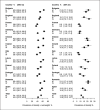Prevalence and Correlates of Overweight and Obesity in 12 European Countries in 2017-2018
- PMID: 35917801
- PMCID: PMC9669997
- DOI: 10.1159/000525792
Prevalence and Correlates of Overweight and Obesity in 12 European Countries in 2017-2018
Abstract
Introduction: Using data from the TackSHS survey, we aim to provide updated estimates on the prevalence and determinants of overweight and obesity in Europe.
Methods: A face-to-face survey was conducted in 2017-2018 in 12 European countries (Bulgaria, England, France, Germany, Greece, Ireland, Italy, Latvia, Poland, Portugal, Romania, and Spain). Overall, 10,810 participants, representative in each country of the general adult population, provided information on self-reported height and weight.
Results: Almost half of participants (48.1%; 95% confidence interval, CI: 47.2-49.1) reported to be overweight or obese (54.1% in men and 42.5% in women) and 12.6% (95% CI: 12.0-13.2) obese (11.3% in men and 13.8% in women). Obesity prevalence was lowest in Italy (7.5%) and France (8.8%) and highest in Greece (19.7%) and Romania (21.1%). Multilevel logistic random-effects analyses showed that prevalence of obesity was related with higher age and lower level of education and socioeconomic status. As compared to northern European countries, Western and Southern European ones showed a significantly lower obesity prevalence. When compared to a companion study conducted in 2010, Eastern and Northern European countries showed an increased trend in obesity prevalence. Conversely, countries with the lowest obesity prevalence (less than 10%), such as Italy and France, showed a decreased trend.
Conclusions: Despite a large heterogeneity across countries, overweight and obesity prevalence estimates in Europe are alarming, with most of the countries reporting obesity prevalence approaching 20% or more, particularly in Eastern and Northern Europe. Since 2010, obesity prevalence increased in most of these countries.
Keywords: Body mass index; Cross-sectional study; Obesity; Overweight; Pan-European survey.
© 2022 The Author(s). Published by S. Karger AG, Basel.
Conflict of interest statement
The authors have no conflicts of interest to declare.
Figures


References
-
- World Health Organization Obesity. 2021. [cited May 2021]. Available from: https://www.euro.who.int/en/health-topics/noncommunicable-diseases/obesi....
-
- World Health Organization Prevalence of obesity. 2021. [cited June 2021]. Available from: https://www.worldobesity.org/about/about-obesity/prevalence-of-obesity.
-
- Krzysztoszek J, Laudanska-Krzeminska I, Bronikowski M. Assessment of epidemiological obesity among adults in EU countries. Ann Agric Environ Med. 2019;26((2)):341–349. - PubMed
-
- Anstey KJ, Cherbuin N, Budge M, Young J. Body mass index in midlife and late-life as a risk factor for dementia: a meta-analysis of prospective studies. Obes Rev. 2011;12((5)):e426–37. - PubMed
Publication types
MeSH terms
LinkOut - more resources
Full Text Sources
Medical
Research Materials

